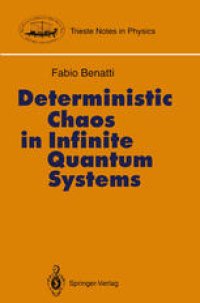
Ebook: Deterministic Chaos in Infinite Quantum Systems
Author: Fabio Benatti (auth.)
- Tags: Thermodynamics, Statistical Physics Dynamical Systems and Complexity, Quantum Information Technology Spintronics, Quantum Physics
- Series: Trieste Notes in Physics
- Year: 1993
- Publisher: Springer-Verlag Berlin Heidelberg
- Edition: 1
- Language: English
- pdf
The purpose of this volume is to give a detailed account of a series of re sults concerning some ergodic questions of quantum mechanics which have the past six years following the formulation of a generalized been addressed in Kolmogorov-Sinai entropy by A.Connes, H.Narnhofer and W.Thirring. Classical ergodicity and mixing are fully developed topics of mathematical physics dealing with the lowest levels in a hierarchy of increasingly random behaviours with the so-called Bernoulli systems at its apex showing a structure that characterizes them as Kolmogorov (K-) systems. It seems not only reasonable, but also inevitable to use classical ergodic theory as a guide in the study of ergodic behaviours of quantum systems. The question is which kind of random behaviours quantum systems can exhibit and whether there is any way of classifying them. Asymptotic statistical independence and, correspondingly, complete lack of control over the distant future are typical features of classical K-systems. These properties are fully characterized by the dynamical entropy of Kolmogorov and Sinai, so that the introduction of a similar concept for quantum systems has provided the opportunity of raising meaningful questions and of proposing some non-trivial answers to them. Since in the following we shall be mainly concerned with infinite quantum systems, the algebraic approach to quantum theory will provide us with the necessary analytical tools which can be used in the commutative context, too.
The concept of entropy as established by Kolmogorov and Sinai turned out to be a useful tool in classical ergodic theory, especially for studying the irregular behaviour of systems. Recently an analogous concept of (non-commutative) entropy for infinite quantum systems was introduced using the algebraic framework of operator algebras. This book, which gives all the definitions and many examples, is a detailed review of this recent work. It compares classical and quantum random behaviour. The notion of quantum chaos is discussed in detail. The book is a review of important work still in progress; it addresses researchers and graduate students.
The concept of entropy as established by Kolmogorov and Sinai turned out to be a useful tool in classical ergodic theory, especially for studying the irregular behaviour of systems. Recently an analogous concept of (non-commutative) entropy for infinite quantum systems was introduced using the algebraic framework of operator algebras. This book, which gives all the definitions and many examples, is a detailed review of this recent work. It compares classical and quantum random behaviour. The notion of quantum chaos is discussed in detail. The book is a review of important work still in progress; it addresses researchers and graduate students.
Content:
Front Matter....Pages I-VI
Introduction....Pages 1-2
Classical Ergodic Theory....Pages 3-52
Algebraic Approach to Classical Ergodic Theory....Pages 53-68
Infinite Quantum Systems....Pages 69-140
Connes-Narnhofer-Thirring Entropy....Pages 141-207
Appendix....Pages 209-212
Back Matter....Pages 213-225
The concept of entropy as established by Kolmogorov and Sinai turned out to be a useful tool in classical ergodic theory, especially for studying the irregular behaviour of systems. Recently an analogous concept of (non-commutative) entropy for infinite quantum systems was introduced using the algebraic framework of operator algebras. This book, which gives all the definitions and many examples, is a detailed review of this recent work. It compares classical and quantum random behaviour. The notion of quantum chaos is discussed in detail. The book is a review of important work still in progress; it addresses researchers and graduate students.
Content:
Front Matter....Pages I-VI
Introduction....Pages 1-2
Classical Ergodic Theory....Pages 3-52
Algebraic Approach to Classical Ergodic Theory....Pages 53-68
Infinite Quantum Systems....Pages 69-140
Connes-Narnhofer-Thirring Entropy....Pages 141-207
Appendix....Pages 209-212
Back Matter....Pages 213-225
....